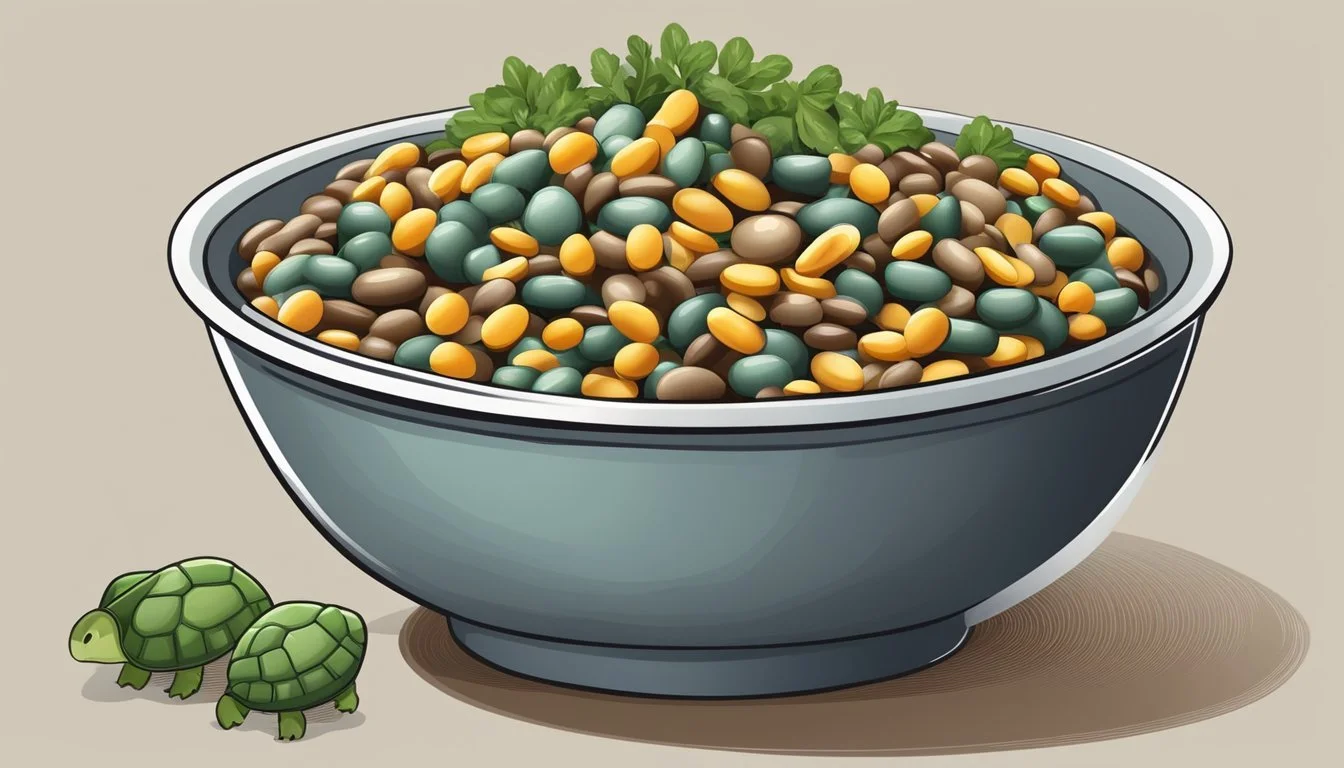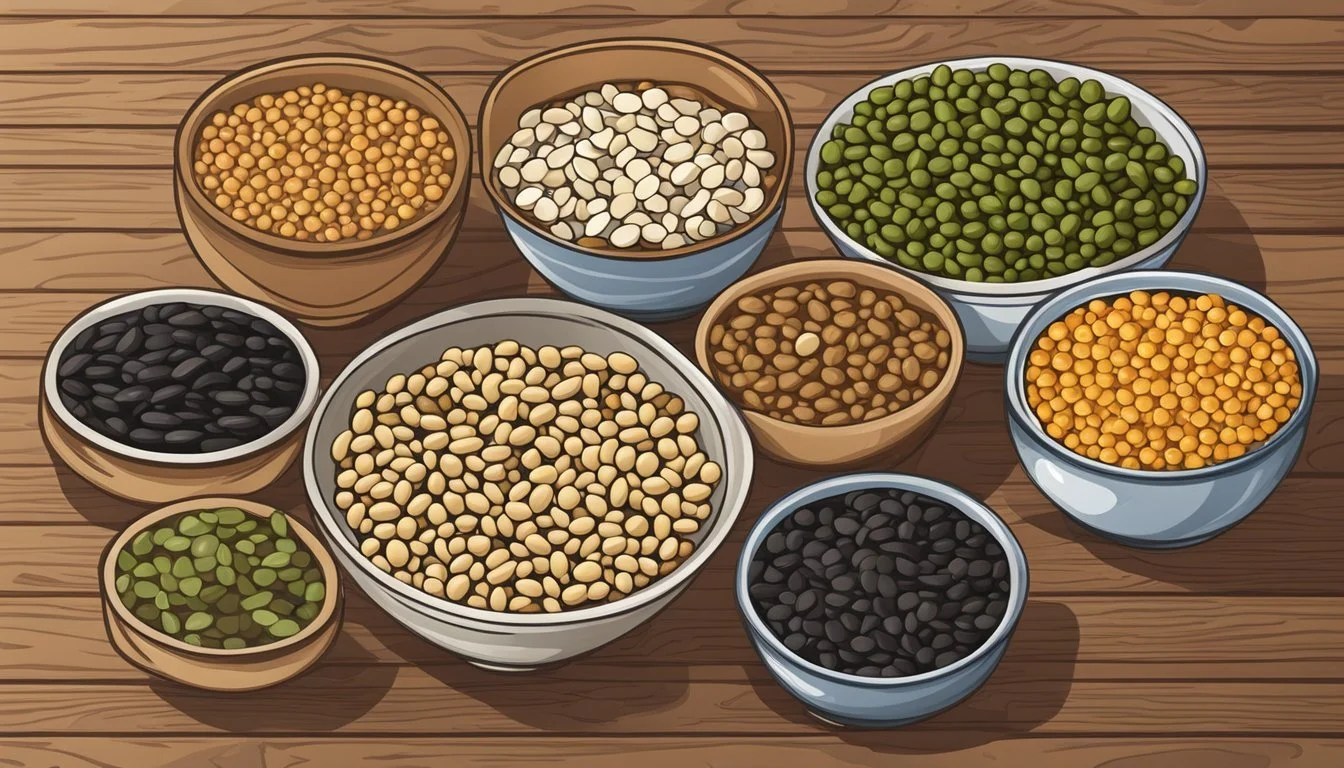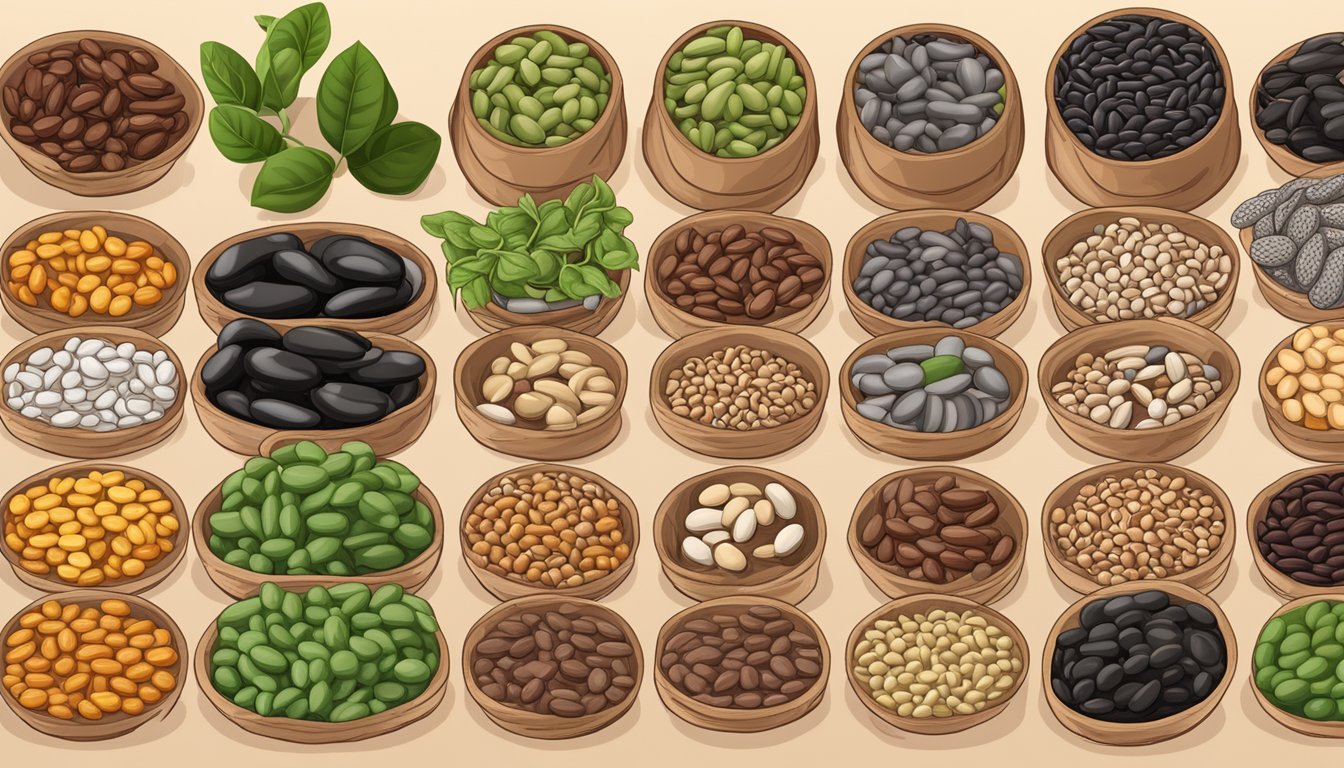Turtle Beans Substitutes
Top Alternatives for Your Recipes
For those who enjoy experimenting in the kitchen, finding suitable substitutes for black turtle beans can be essential when this ingredient is unavailable. Known for their rich, earthy flavor and versatility in cooking, black turtle beans are a staple in many Latin American and Caribbean dishes. A standout substitute is black beans, which can seamlessly replace black turtle beans in most recipes due to their similar texture and flavor profile.
Another excellent alternative is pinto beans. Pinto beans offer a slightly nutty flavor and a creamy texture, making them a good fit in soups, stews, and dips. They are also highly versatile, allowing them to be incorporated into various dishes from tacos to chili. For those looking to maintain the unique taste associated with black turtle beans, pink beans can also be considered due to their mild taste and adaptable nature.
Kidney beans, with their robust flavor and firm texture, also serve as an effective substitute in many recipes that call for black turtle beans. By understanding and utilizing these substitutes, one can continue to enjoy flavorful and hearty dishes without compromising on taste or texture.
Understanding Bean Substitutes
Selecting an appropriate substitute for turtle beans requires attention to nutritional content, flavor profile, and culinary applications. Different substitutes will suit different dishes and dietary needs.
Nutritional Considerations
Turtle beans, like many legumes, are high in protein and rich in fiber. When looking for substitutes, it’s essential to choose those that also provide significant protein and fiber content.
Pinto beans: An excellent source of protein and fiber, making them a nutritious alternative.
Red beans: Similar nutritional profile with a good balance of protein and fiber.
Butter beans: Provide a creamy texture but slightly lower in protein compared to turtle beans.
Nutritional values for these substitutes support various dietary needs, including those focused on maintaining balanced protein intake and digestive health.
Flavor Profiles
The nutty flavor of turtle beans can be challenging to replicate exactly, but several substitutes offer unique tastes that can complement various dishes.
Pinto beans: Have a slightly nutty flavor, making them an appropriate substitute in many recipes.
Red beans: Offer a stronger taste, suitable for robust flavors in savory meals.
Black-eyed peas: Include a mild flavor that blends well into a variety of dishes without overpowering other ingredients.
Substituting beans impacts the overall flavor of the dish, and choosing the right substitute depends on the desired taste profile.
Culinary Uses
Turtle beans’ versatility in cooking makes them a staple in many dishes, especially in Mexican cuisine and slow-cooked dishes. When substituting:
Pinto beans: Perfect for refried beans, soups, and chili.
Red beans: Work well in Creole and Cajun dishes, giving depth to hearty stews.
Butter beans: Best in salads or as a side dish, offering a creamy consistency.
Effectively substituting turtle beans involves matching the texture and cooking requirements of the original recipe, ensuring the final dish retains its intended culinary essence.
Common Black Turtle Bean Substitutes
When looking for alternatives to black turtle beans, several substitutes offer comparable taste, texture, and nutritional benefits. The best options include black beans, pinto beans, kidney beans, and great northern beans.
Black Beans
Black beans are a primary substitute for black turtle beans. They share a similar deep color and earthy flavor. These beans are firmer and hold up well in a variety of dishes.
Cooking time for black beans is shorter, making them convenient. They work well in soups, stews, and salads. Nutritionally, black beans are high in protein and fiber, making them a nutritious option.
Key Attributes:
Texture: Firm
Flavor: Earthy
Nutritional Content: High in protein and fiber
Pinto Beans
Pinto beans, known as frijol pinto, offer a different texture and taste. They are softer and creamier when cooked, with a slightly nutty flavor. These beans are common in Mexican cuisine and adaptable to various dishes.
Pinto beans are versatile for use in refried beans, chili, and burritos. They also cook relatively quickly and absorb flavors well.
Key Attributes:
Texture: Soft and creamy
Flavor: Nutty
Nutritional Content: Good source of protein and fiber
Kidney Beans
Kidney beans are another suitable substitute. They provide a denser texture and have a slightly sweet flavor. These beans are ideal for hearty dishes as they retain shape during cooking.
Commonly used in chili and soups, kidney beans are robust and maintain their integrity. They are rich in essential nutrients, including iron and vitamins.
Key Attributes:
Texture: Dense
Flavor: Slightly sweet
Nutritional Content: Rich in iron and vitamins
Great Northern Beans
Great northern beans are milder in flavor and have a smooth, firm texture. They are prevalent in casseroles and stews due to their ability to absorb flavors.
These beans are larger and often seen in baked bean recipes. They are nutritionally beneficial, offering a good amount of protein and low fat.
Key Attributes:
Texture: Smooth and firm
Flavor: Mild
Nutritional Content: High in protein, low in fat
Specialty Bean Alternatives
This section explores several specialty bean alternatives to turtle beans, focusing on their unique flavors, textures, and nutritional benefits.
Cannellini Beans
Cannellini beans are large, white beans with a creamy texture and a mild, nutty flavor. They are an excellent substitute for turtle beans in soups, stews, and salads due to their ability to absorb flavors well. These beans are also rich in protein and fiber, making them a nutritious option.
They hold their shape well during cooking, which makes them ideal for dishes that require longer simmering times. Cannellini beans are commonly used in Italian cuisine and can seamlessly replace turtle beans in recipes like minestrone and bean salads.
Borlotti Beans
Borlotti beans, also known as cranberry beans, are another great alternative to turtle beans. They have a distinct reddish-brown color with dark speckles and offer a slightly sweet, nutty flavor. These beans are packed with essential nutrients, such as iron, magnesium, and potassium.
They have a creamy texture that works well in a variety of dishes, including chili, soups, and casseroles. Borlotti beans are especially popular in Mediterranean cuisine, where they are often featured in hearty stews and bean salads.
Adzuki Beans
Adzuki beans are small, reddish-brown beans known for their slightly sweet flavor. They are a staple in Asian cuisine, particularly in Japanese and Chinese dishes. These beans are high in protein and fiber, as well as essential vitamins and minerals.
Adzuki beans are versatile and can be used in both savory and sweet dishes. In savory dishes, they can replace turtle beans in soups, stews, and rice dishes. They are also commonly used in desserts, such as red bean paste, due to their natural sweetness.
Anasazi Beans
Anasazi beans are speckled, reddish-brown beans with a unique history and a slightly sweet flavor. They are known for their faster cooking times and lower gas-producing qualities compared to other beans. Anasazi beans are rich in protein, fiber, and various micronutrients.
Their creamy texture and mild flavor make them suitable for a wide range of recipes, including soups, stews, and casseroles. These beans can easily substitute for turtle beans while adding a touch of historical and cultural significance to your dishes.
Legumes Beyond Beans
When looking for alternatives to turtle beans, several legumes provide unique flavors, textures, and nutritional benefits. This section delves into chickpeas, lentils, black-eyed peas, cowpeas, pigeon peas, and urad beans, each offering diverse culinary applications and health advantages.
Chickpeas
Chickpeas, also known as garbanzo beans, boast a nutty flavor and firm texture that make them an excellent substitute for beans in various dishes. They are nutritious, offering high levels of protein, dietary fiber, and essential minerals such as iron and magnesium. These legumes can be used in salads, soups, and stews or mashed to form spreads like hummus.
Dried or canned forms are available. Cooking dried chickpeas requires soaking and simmering until tender. In addition to their culinary versatility, chickpeas can also support gut health due to their fiber content. This makes them not only a tasty but also a health-supportive alternative to turtle beans.
Lentils
Lentils come in various types, including green, brown, red, and yellow, each with distinct culinary uses. They are quick-cooking and do not need soaking, making them convenient for time-efficient meal preparation. Lentils provide significant amounts of protein, fiber, and essential vitamins and minerals, such as folate and manganese.
These legumes can be used in soups, stews, salads, or even as a meat substitute in patties. Due to their versatility and nutritional profile, lentils are a valuable addition to any diet seeking to replace turtle beans. They can mimic the texture of beans in many recipes while enhancing the nutritional value.
Black-Eyed Peas and Cowpeas
Black-eyed peas, a variety of cowpeas, are recognized for their creamy texture and distinctive flavor. They are rich in nutrients, including protein, fiber, folate, iron, and potassium. Black-eyed peas are often used in Southern and West African cuisines, highlighting their cultural and culinary importance.
These legumes are versatile and can be substituted for beans in soups, stews, and salads. They cook relatively quickly and do not require extensive soaking. For those looking to diversify their legume intake, black-eyed peas present a nutritious and flavorful choice.
Pigeon Peas and Urad Beans
Pigeon peas are versatile legumes commonly used in Asian, African, and Caribbean cuisines. They have a slightly sweet, nutty flavor and are rich in protein, fiber, and essential minerals. These peas can be used in soups, stews, rice dishes, and even as a standalone side dish.
Urad beans, or black gram, are small, black legumes that are particularly significant in Indian cooking. They are used to make dals, as well as the popular South Indian dish, dosa. Urad beans are nutritious, containing protein, dietary fiber, and minerals like iron. They add a unique flavor and texture to meals, making them a practical substitute for turtle beans.
Non-Bean Protein Alternatives
For those seeking non-bean protein alternatives, grains with protein and soy-based products offer nutritious options. These choices can be versatile and satisfying when turtle beans are not available.
Grains with Protein
Grains can be surprisingly rich in protein. Quinoa, often considered a supergrain, contains about 8 grams of protein per cup when cooked. Unlike many grains, quinoa is a complete protein, providing all nine essential amino acids.
Amaranth is another excellent choice, offering around 9 grams of protein per cup. These grains are not just high in protein but also gluten-free, making them suitable for various dietary needs.
Other grains include buckwheat and farro, both providing decent protein content and fiber. These grains can be incorporated into salads, soups, or served as side dishes.
Soybeans and Tofu
Soybeans and tofu are among the most common non-bean protein sources. Soybeans are high in protein, with about 28 grams per cup when boiled. They can be consumed as edamame or processed into products like soy milk and tempeh.
Tempeh, a fermented soybean product, contains around 21 grams of protein per 3-ounce serving. It offers a firm texture and nutty flavor, ideal for various dishes.
Tofu, made from soybean curds, comes in different textures: silken, soft, firm, and extra firm. Each provides about 10 grams of protein per half-cup serving, making it a versatile ingredient for stir-fries, soups, and even desserts.
Choosing the Right Substitute
Selecting an appropriate substitute for turtle beans involves considering the specific dish, the availability of options, and regional varieties. Each factor can impact flavor, texture, and overall success.
Considering the Dish
When choosing a substitute for turtle beans, it is critical to think about the nature of the dish. For slow-cooked dishes like stews, chili, or soups, beans that hold up well over long cooking times, such as black-eyed peas or kidney beans, are ideal.
In Mexican cuisine, where turtle beans are often used due to their unique flavor, pinto beans or black turtle beans can be effective substitutes. The goal is to match the mild, earthy flavors and textures typical of these dishes.
Availability and Accessibility
Canned beans offer convenience and a shorter cooking time. Substitutes such as canned black beans or navy beans are widely available and can be easily found in most grocery stores.
For those preferring dried beans, it's essential to consider rehydration and cooking times. Adzuki and Borlotti beans are reliable options but may require additional soaking and cooking effort.
Moreover, some bean varieties such as the alavese pinto bean and burke bean might be rare in certain locations, affecting their feasibility as substitutes.
Bean Varieties by Region
Bean varieties differ significantly by region. In regions where turtle beans are less common, Great Northern beans or Lima beans might be the available alternatives.
In areas like South America, black beans or caraotas negras are excellent substitutes given their similar flavor profiles. In North America, locally accessible beans such as othello beans and hidatsa beans can serve as suitable replacements.
Understanding these regional differences helps make an informed decision, ensuring the selected substitute complements the dish without compromising flavor or texture. Token beans that share close regional ties could often offer a more authentic taste and the desired culinary outcome.








